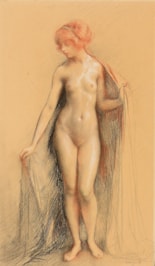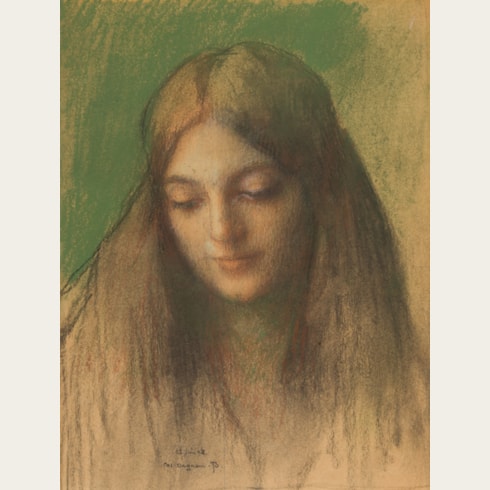Pascal-Adolphe DAGNAN-BOUVERET
(Paris 1852 - Quincey 1929)
A Standing Female Nude (Primavera)
Sold
Black and red chalk, heightened with white, on paper laid down on board.
Signed PAd Dagnan-B. at the lower right.
306 x 175 mm. (12 x 6 7/8 in.) [image]
324 x 205 mm. (12 3/4 x 8 1/8 in.) [sheet]
Signed PAd Dagnan-B. at the lower right.
306 x 175 mm. (12 x 6 7/8 in.) [image]
324 x 205 mm. (12 3/4 x 8 1/8 in.) [sheet]
Dagnan-Bouveret worked painstakingly on his paintings, making numerous preparatory drawings for each composition. The present sheet is a preparatory study for the painting Primavera of 1914, today in the collection of the Sterling and Francine Clark Art Institute in Williamstown, Massachusetts. When the painting was shown (as an ‘Étude inachevée’, or an unfinished study) at the Paris Salon of 1920, a review of the exhibition noted that ‘As an offering for his return to the fold, from which his already glorious springtime once sprang forth, Mr. Dagnan brings a Primavera, youthful, redheaded, slender, and nude, who emerges, in full relief, with an exquisite gesture of her head and arms, from a green veil where the new season dawns; and in her slenderness there is all the grace of the unfinished.’
As a modern scholar has noted of the Clark painting, ‘The timeless and idealized nude of Primavera evokes the allegorical figures and nymphs that populate the oeuvres of such Symbolist artists as Alphonse Osbert (1857-1939) and Lucien Lévy-Dhurmer (1865-1953).’
As a modern scholar has noted of the Clark painting, ‘The timeless and idealized nude of Primavera evokes the allegorical figures and nymphs that populate the oeuvres of such Symbolist artists as Alphonse Osbert (1857-1939) and Lucien Lévy-Dhurmer (1865-1953).’
Pascal-Adolphe-Jean Dagnan-Bouveret entered the Ecole des Beaux-Arts in 1869, studying first with Alexandre Cabanel and then with Jean-Léon Gérôme. He first exhibited at the Salon in 1875, showing a painting -which was purchased by the State - and two drawings. He won second place in the Prix de Rome competition of 1876, but by 1878 had left the Ecole des Beaux-Arts. Following a visit to Franche-Comté later that year, Dagnan-Bouveret was inspired to paint subjects taken from rural life, and became a major exponent of naturalism in the later 19th century. He won medals at the Salons of 1878 and 1880, and his reputation was firmly established at the Salon of 1885, when a large painting of Horses at a Watering Place was acquired by the State. In the same year the artist was received into the Légion d’honneur, and made the first of several trips to Brittany, which was to be the inspiration for a number of important works of the later 1880s and early 1900s.
Among his most significant paintings of Breton subjects was The Pardon in Brittany, exhibited with much critical success at the Salon of 1878 and the Exposition Universelle of 1889 and today in the Metropolitan Museum of Art in New York. Dagnan-Bouveret also showed at the Salon de la Société Nationale from its inauguration in 1890 and, in the same year, at the Société des Pastellistes. From the 1890s onwards he began concentrating on portrait painting, for which he received several official commissions. Elected to the Institut de France in 1900, Dagnan-Bouveret received a grand prize at the Exposition Universelle the same year. In 1910 an album of facsimile reproductions of some of his portrait and figure drawings was published, with the title Choix de dessins de Dagnan-Bouveret. In 1930, a year after the artist’s death, a large retrospective exhibition of his oeuvre was held at the Ecole des Beaux-Arts, although by this time he was something of an anachronism, with his work long out of fashion.
Among his most significant paintings of Breton subjects was The Pardon in Brittany, exhibited with much critical success at the Salon of 1878 and the Exposition Universelle of 1889 and today in the Metropolitan Museum of Art in New York. Dagnan-Bouveret also showed at the Salon de la Société Nationale from its inauguration in 1890 and, in the same year, at the Société des Pastellistes. From the 1890s onwards he began concentrating on portrait painting, for which he received several official commissions. Elected to the Institut de France in 1900, Dagnan-Bouveret received a grand prize at the Exposition Universelle the same year. In 1910 an album of facsimile reproductions of some of his portrait and figure drawings was published, with the title Choix de dessins de Dagnan-Bouveret. In 1930, a year after the artist’s death, a large retrospective exhibition of his oeuvre was held at the Ecole des Beaux-Arts, although by this time he was something of an anachronism, with his work long out of fashion.





